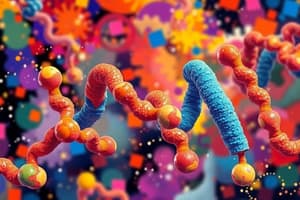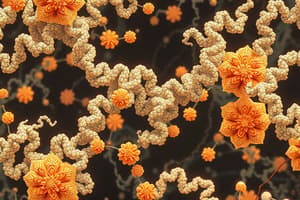Podcast
Questions and Answers
What defines the primary structure of a protein?
What defines the primary structure of a protein?
- The arrangement of protein subunits
- The presence of disulfide bonds between peptide chains
- The unique sequence of amino acids in a polypeptide chain (correct)
- The folding of the polypeptide into a three-dimensional shape
What role do disulfide bonds play in protein structure?
What role do disulfide bonds play in protein structure?
- They act as a primary structural component
- They stabilize the three-dimensional conformation of proteins (correct)
- They determine the specific sequence of amino acids
- They are involved in peptide bond formation
In sickle cell anemia, what specific change occurs in the hemoglobin structure?
In sickle cell anemia, what specific change occurs in the hemoglobin structure?
- The polypeptide chains become longer
- A missing amino acid in the alpha chain
- An additional alpha chain is added
- A valine replaces a glutamic acid in the beta chain (correct)
Which level of protein structure is characterized by the local folding into alpha helices and beta sheets?
Which level of protein structure is characterized by the local folding into alpha helices and beta sheets?
What primarily determines the unique sequence of a protein's primary structure?
What primarily determines the unique sequence of a protein's primary structure?
How does the alteration of an enzyme's active site affect its function?
How does the alteration of an enzyme's active site affect its function?
What is the primary structural difference between normal hemoglobin and sickle cell hemoglobin?
What is the primary structural difference between normal hemoglobin and sickle cell hemoglobin?
What are the four levels of protein structure?
What are the four levels of protein structure?
What is a characteristic feature of the primary structure of insulin?
What is a characteristic feature of the primary structure of insulin?
Which amino acid is replaced in sickle cell hemoglobin compared to normal hemoglobin?
Which amino acid is replaced in sickle cell hemoglobin compared to normal hemoglobin?
What process results in the transmission of sickle cell anemia from parents to children?
What process results in the transmission of sickle cell anemia from parents to children?
How does sickle cell hemoglobin affect red blood cells?
How does sickle cell hemoglobin affect red blood cells?
What are potential health issues faced by individuals with sickle cell anemia?
What are potential health issues faced by individuals with sickle cell anemia?
What is the consequence of the long fibers formed by sickle cell hemoglobin?
What is the consequence of the long fibers formed by sickle cell hemoglobin?
What is the length of the beta chain of hemoglobin?
What is the length of the beta chain of hemoglobin?
What microscopy technique was used to visualize sickle cells in the provided data?
What microscopy technique was used to visualize sickle cells in the provided data?
What type of amino acids typically reside in the interior of a protein during folding?
What type of amino acids typically reside in the interior of a protein during folding?
Which type of bond forms between cysteine side chains in the presence of oxygen during protein folding?
Which type of bond forms between cysteine side chains in the presence of oxygen during protein folding?
Which type of protein structure involves the interaction of several polypeptide subunits?
Which type of protein structure involves the interaction of several polypeptide subunits?
What is the primary consequence of denaturation in a protein?
What is the primary consequence of denaturation in a protein?
Which type of interaction is primarily responsible for maintaining the tertiary structure of proteins?
Which type of interaction is primarily responsible for maintaining the tertiary structure of proteins?
What is the result of post-translational modification in the context of insulin folding?
What is the result of post-translational modification in the context of insulin folding?
What might cause a protein to denature?
What might cause a protein to denature?
What type of protein structure is characterized by a β-pleated sheet arrangement?
What type of protein structure is characterized by a β-pleated sheet arrangement?
What are the two most common types of secondary structures in proteins?
What are the two most common types of secondary structures in proteins?
How are secondary structures like the α-helix and β-pleated sheet primarily held together?
How are secondary structures like the α-helix and β-pleated sheet primarily held together?
What is the significance of the R groups in the α-helix structure?
What is the significance of the R groups in the α-helix structure?
What is the primary interaction responsible for the formation of a protein's tertiary structure?
What is the primary interaction responsible for the formation of a protein's tertiary structure?
In the β-pleated sheet structure, how are the pleated segments aligned?
In the β-pleated sheet structure, how are the pleated segments aligned?
What prevents R groups with like charges from getting close to each other in tertiary structures?
What prevents R groups with like charges from getting close to each other in tertiary structures?
How many amino acid residues are there in each helical turn of an α-helix?
How many amino acid residues are there in each helical turn of an α-helix?
Which type of bond is largely responsible for the formation of hydrogen bonds in protein secondary structures?
Which type of bond is largely responsible for the formation of hydrogen bonds in protein secondary structures?
Flashcards are hidden until you start studying
Study Notes
Protein Structure
- Primary Structure: The unique amino acid sequence of a polypeptide chain is its primary structure.
- Example: Insulin has two polypeptide chains (A and B) linked by disulfide bonds. Each chain has a unique amino acid sequence.
Secondary Structure
- Structure: Local folding of the polypeptide chain into α-helix or β-pleated sheet structures.
- Formation: Held in shape by hydrogen bonds between the oxygen atom in the carbonyl group of one amino acid and another amino acid four residues away in the chain.
- R Groups: Stick out from the α-helix chain. In β-pleated sheets, R groups extend above and below the pleat's folds.
- Types: α-helix (3.6 residues per turn), β-pleated sheet (parallel or antiparallel arrangements).
- Prevalence: Found in most globular and fibrous proteins.
Tertiary Structure
- Structure: The unique three-dimensional structure of a polypeptide.
- Formation: Interactions between R groups (hydrophobic interactions, ionic bonds, hydrogen bonding, and disulfide linkages).
- Hydrophobic Interactions: Nonpolar amino acids with hydrophobic R groups fold to the protein's interior, while hydrophilic R groups are on the outside.
- Disulfide Linkages: Covalent bonds formed between cysteine side chains in the presence of oxygen.
- Role: Determines protein shape and function.
Quaternary Structure
- Structure: Formation of proteins from multiple polypeptide subunits.
- Interaction: Weak interactions between subunits stabilize the overall structure.
- Example: Insulin (globular protein) with hydrogen and disulfide bonds forms a ball-like shape.
- Example: Silk (fibrous protein) has a β-pleated sheet structure due to hydrogen bonding between different chains.
Denaturation and Protein Folding
- Denaturation: Loss of protein shape without losing the primary sequence.
- Causes: Changes in temperature, pH, exposure to chemicals.
- Reversibility: Often reversible if the denaturing agent is removed, allowing the protein to regain function.
- Irreversibility: Sometimes denaturation is irreversible, resulting in loss of function.
Studying That Suits You
Use AI to generate personalized quizzes and flashcards to suit your learning preferences.




